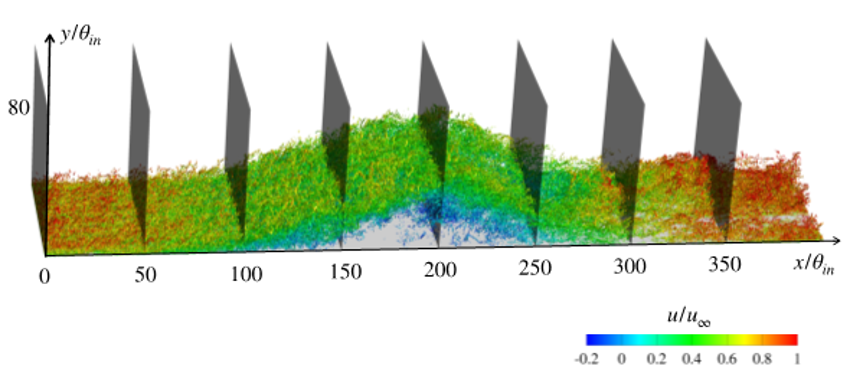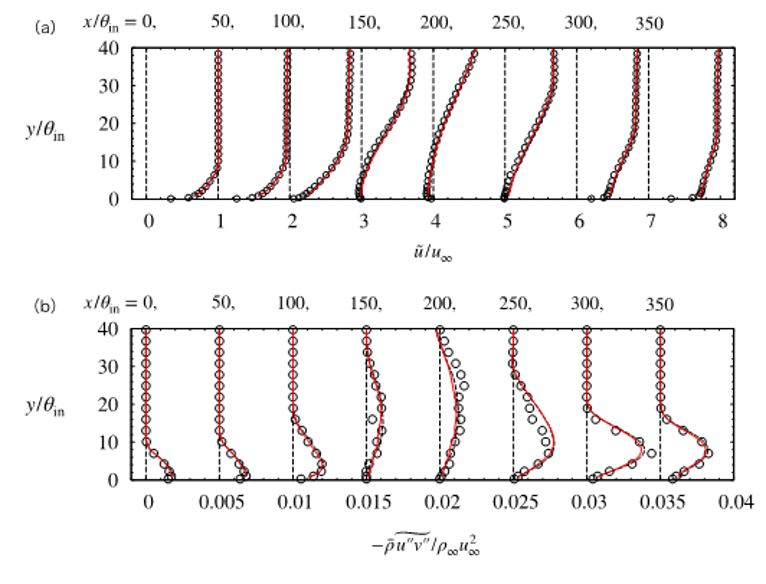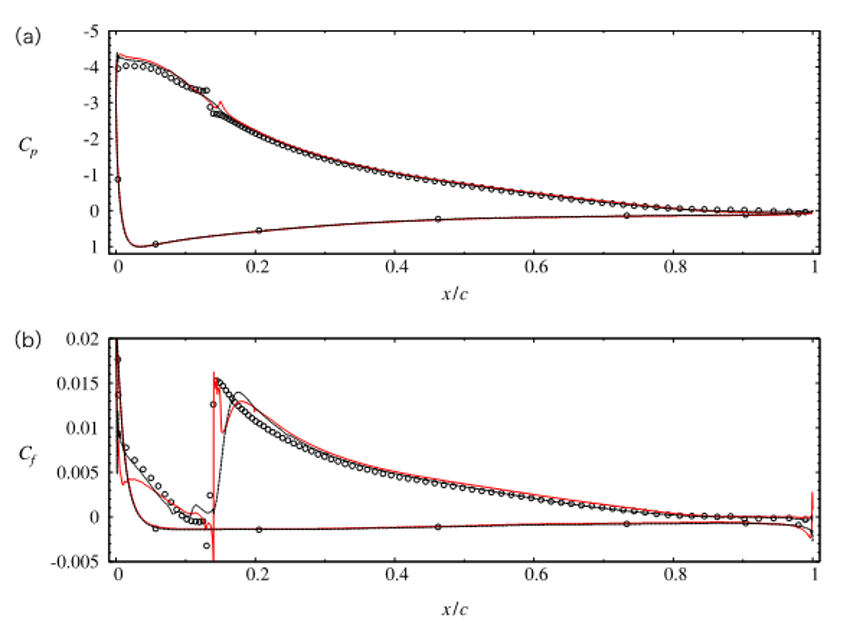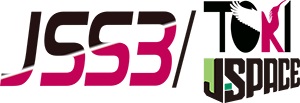High-fidelity numerical simulation of compressible turbulent flows
JAXA Supercomputer System Annual Report April 2020-March 2021
Report Number: R20EACA37
Subject Category: JSS Inter-University Research
- Responsible Representative: Soshi Kawai, Professor, Department of Aerospace Engineering, Tohoku University
- Contact Information: Hiroyuki Asada(h.asada@tohoku.ac.jp)
- Members: Soshi Kawai, Ryo Kamogawa, Hiroyuki Asada, Aya Aihara
Abstract
To accurately simulate turbulent flows with separation and reattachment using wall-modeled large-eddy simulation (LES), non-equilibrium effects, such as the effects of the pressure gradient, should be incorporated in the wall model. However, the existing non-equilibrium wall-models require solving the partial differential equations (PDEs), which increase the difficulty of implementation, especially for complex geometries. Therefore, we construct and validate a non-equilibrium wall-model based on the ordinary differential equation (ODE). First, the non-equilibrium effects of turbulent boundary layers (i.e., the pressure-gradient and convective terms) and the eddy viscosity are consistently modeled using the wall-resolved LES database of the flat-plate separating/reattaching turbulent boundary layers. Then, we perform wall-modeled LES of the flat-plate turbulent boundary layer with separation/reattachment and a near-stall airfoil flow using the proposed ODE-based non-equilibrium wall model. In both the validation cases, the wall-modeled LES using the proposed wall model show a good agreement with the reference wall-resolved LES results.
Reference URL
Please refer to http://www.klab.mech.tohoku.ac.jp/ .
Reasons and benefits of using JAXA Supercomputer System
In this study, a newly-proposed wall model is validated. Since the wall-modeled LES is an unsteady 3D calculation, parallel computations using a supercomputer are required. Also, to propose and validate a new wall model, several computational cases with different settings need to be conducted. Therefore, our research requires massively parallel computations using JAXA’s supercomputer.
Achievements of the Year
(a)An ODE-based non-equilibrium wall model is constructed based on the wall-resolved LES database of the flat-plate separating/reattaching turbulent boundary layers. In the proposed wall model, the non-equilibrium terms, pressure-gradient and convective terms, are modeled using the flow quantities at the matching location of the wall model. Also, the eddy viscosity is modeled consistently with the pressure-gradient and convective terms. The implementation of the proposed model is easier than the existing PDE-based non-equilibrium wall model. Then, we conduct the wall-modeled LES using the proposed ODE-based wall model (ODE-NEQWM) for the flat-plate separating turbulent boundary layers and compare the results with the wall-resolved LES database as well as the wall-modeled LES using the existing PDE-based non-equilibrium wall model (PDE-NEQWM). The mean streamwise velocity and Reynolds shear stress profiles obtained by the proposed ODE-NEQWM show a good agreement with those of LES and PDE-NEQWM. The results indicate that the proposed ODE-based non-equilibrium wall model has comparable accuracy with the existing PDE-based wall model.
(b)As a more practical validation case, a high Reynolds number (the Reynolds number based on the chord length is 2.1*10^6) flow around the A-airfoil at a near-stall condition (the angle of attack is 13.3 degrees) is simulated using the proposed wall-modeled LES (ODE-NEQWM). The mean pressure coefficient and the skin-friction coefficient obtained by ODE-NEQWM show a good agreement with the reference data of the wall-resolved LES database and the wall-modeled LES using the existing PDE-based wall model. The results obtained by the proposed wall-modeled LES show a robustness to predict a more practical airfoil flow near a stall condition.

Fig.1: Isosurfaces of the Q-criterion colored by the streamwise velocity in the flat-plate separating/reattaching turbulent boundary layer

Fig.2: Profiles of (a) the mean streamwise velocity and (b) Reynolds shear stress in separating/reattaching turbulent boundary layer (circles, wall-resolved LES; red solid lines, the proposed ODE-based non-equilibrium wall-modeled LES; black dashed lines, the existing PDE-based non-equilibrium wall-modeled LES)

Fig.3: Isosurfaces of the Q-criterion colored by the streamwise velocity in the flow around A-airfoil

Fig.4: Distributions of mean skin friction and pressure coefficients along the A-airfoil (circles, wall-resolved LES; red solid lines, the proposed ODE-based non-equilibrium wall-modeled LES; black dashed lines, the existing PDE-based non-equilibrium wall-modeled LES)
Publications
– Oral Presentations
(1) R. Kamogawa, Y. Tamaki, and S. Kawai, “Modeling of the non-equilibrium effects of separated turbulent boundary layer for ODE-based wall-modeled LES”, 34th CFD symposium, Online, 2020.
Usage of JSS
Computational Information
- Process Parallelization Methods: MPI
- Thread Parallelization Methods: OpenMP
- Number of Processes: 416
- Elapsed Time per Case: 200 Hour(s)
Resources Used(JSS2)
Fraction of Usage in Total Resources*1(%): 0.15
Details
Please refer to System Configuration of JSS2 for the system configuration and major specifications of JSS2.
| System Name | Amount of Core Time(core x hours) | Fraction of Usage*2(%) |
|---|---|---|
| SORA-MA | 903,245.69 | 0.17 |
| SORA-PP | 0.00 | 0.00 |
| SORA-LM | 0.00 | 0.00 |
| SORA-TPP | 0.00 | 0.00 |
| File System Name | Storage Assigned(GiB) | Fraction of Usage*2(%) |
|---|---|---|
| /home | 22.32 | 0.02 |
| /data | 3,522.01 | 0.07 |
| /ltmp | 4,572.09 | 0.39 |
| Archiver Name | Storage Used(TiB) | Fraction of Usage*2(%) |
|---|---|---|
| J-SPACE | 0.00 | 0.00 |
*1: Fraction of Usage in Total Resources: Weighted average of three resource types (Computing, File System, and Archiver).
*2: Fraction of Usage:Percentage of usage relative to each resource used in one year.
Resources Used(JSS3)
Fraction of Usage in Total Resources*1(%): 0.01
Details
Please refer to System Configuration of JSS3 for the system configuration and major specifications of JSS3.
| System Name | Amount of Core Time(core x hours) | Fraction of Usage*2(%) |
|---|---|---|
| TOKI-SORA | 0.00 | 0.00 |
| TOKI-RURI | 0.00 | 0.00 |
| TOKI-TRURI | 0.00 | 0.00 |
| File System Name | Storage Assigned(GiB) | Fraction of Usage*2(%) |
|---|---|---|
| /home | 22.52 | 0.02 |
| /data | 3,523.93 | 0.06 |
| /ssd | 225.17 | 0.12 |
| Archiver Name | Storage Used(TiB) | Fraction of Usage*2(%) |
|---|---|---|
| J-SPACE | 0.00 | 0.00 |
*1: Fraction of Usage in Total Resources: Weighted average of three resource types (Computing, File System, and Archiver).
*2: Fraction of Usage:Percentage of usage relative to each resource used in one year.
JAXA Supercomputer System Annual Report April 2020-March 2021


